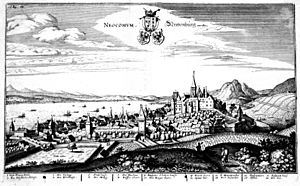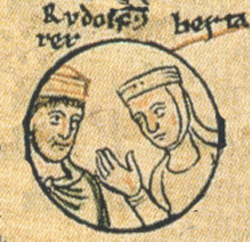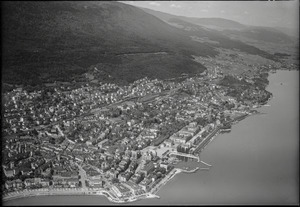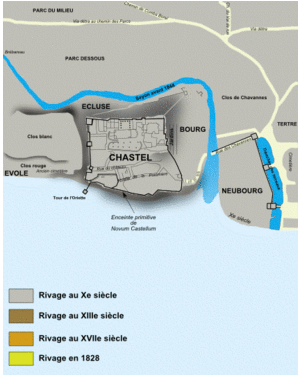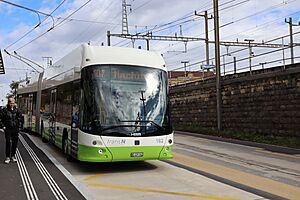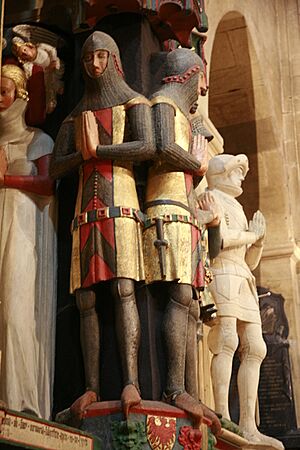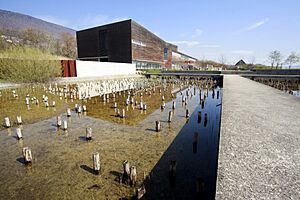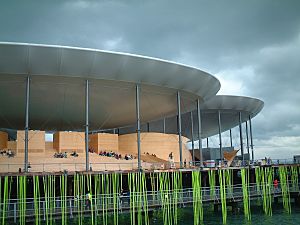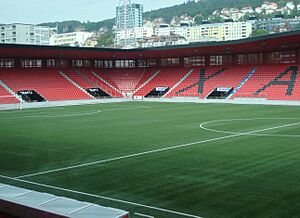Neuchâtel facts for kids
Quick facts for kids
Neuchâtel
|
||
|---|---|---|
 |
||
|
||
| Country | Switzerland | |
| Canton | Neuchâtel | |
| Area | ||
| • Total | 30.11 km2 (11.63 sq mi) | |
| Elevation
(railway station)
|
479 m (1,572 ft) | |
| Highest elevation
(Grand Chaumont)
|
1,177 m (3,862 ft) | |
| Lowest elevation
(Port)
|
434 m (1,424 ft) | |
| Population
(Dec 2020 )
|
||
| • Total | 33,455 | |
| • Density | 1,111.09/km2 (2,877.7/sq mi) | |
| Demonym(s) | French: Neuchâtelois(e) | |
| Postal code |
2000
|
|
| Localities | La Coudre, Serrières, Pierre-à-Bot, Gorges du Seyon, Chaumont, Petit Chaumont, Grand Chaumont, Peseux, Corcelles-Cormondrèche, Valangin | |
| Surrounded by | Auvernier, Boudry, Chabrey (VD), Colombier, Cressier, Cudrefin (VD), Delley-Portalban (FR), Enges, Fenin-Vilars-Saules, Hauterive, Saint-Blaise, Savagnier | |
| Twin towns | Aarau (Switzerland), Besançon (France), Sansepolcro (Italy) | |
Neuchâtel (pronounced "Noo-sha-TEL") is a city in Switzerland. It is the capital of the Swiss canton of Neuchâtel. The city is located on the beautiful Lake Neuchâtel.
In 2021, Neuchâtel joined with the nearby towns of Corcelles-Cormondrèche, Peseux, and Valangin. Now, the city has about 33,000 people living in it. Both the French name "Neuchâtel" and the German name "Neuenburg" mean "New Castle."
The castle that gave the city its name was finished in 1011. Neuchâtel was once part of the Kingdom of Burgundy and later the Holy Roman Empire. It was controlled by Prussia from 1707 to 1848. In 1848, Neuchâtel became a republic and joined Switzerland.
Today, Neuchâtel is known for its watchmaking and high-tech industries. It is home to important research centers like the Swiss Center for Electronics and Microtechnology (CSEM).
Contents
What does the name Neuchâtel mean?
The name Neuchâtel comes from old French words. Neu means "new" and châtel means "castle." So, Neuchâtel means "new castle." This name refers to the castle built in the 10th century.
The German name for the town is Neuenburg. This also means "new castle." Sometimes people say Neuenburg am See ("Newcastle by the lake") to be clear. This helps tell it apart from other places named Neuenburg.
Old names for Neuchâtel
The old Latin name for Neuchâtel was Neocomum. This name is still seen on the seal of the University of Neuchâtel. Other old Latin names were Novum castellum (1011) and Novum Castrum (1143).
Some old French names included Nuefchastel (1251) and Neufchastel (1338). The modern name Neuchâtel was used by 1750.
German names for the town included Nienburg and Nüwenburg. The modern name Neuenburg was used by 1725.
A brief history of Neuchâtel
Early human life
The oldest signs of humans in Neuchâtel are from about 13,000 BC. These were found at a hunting camp. People hunted horses and reindeer there. Later, around 11,000 BC, other hunters used the same spot. They hunted deer and wild boar.
In 1999, an old village was found near the railway station. It was a village from the Middle Neolithic period. Some parts of the village were from 3571 BC.
From castle to city
In 1011, Rudolph III of Burgundy gave a "new castle" on the lake to his wife. This castle became the center of a new royal court.
Soon after, the first counts of Neuchâtel were named. In 1214, their land was officially called a city.
Becoming a principality
For 300 years, the area of Neuchâtel grew. In 1530, the people of Neuchâtel chose to follow the Reformation. This meant their city and land would always stay together.
Neuchâtel became a principality in the early 1600s. In 1707, the ruler died without an heir. The people chose Frederick I of Prussia as their new prince. They wanted a Protestant ruler who was strong but far away. This brought peace and growth to Neuchâtel. Industries like watchmaking and banking grew a lot.
Modern times
In 1806, during the Napoleonic Wars, Neuchâtel was given to Napoleon's general, Louis Alexandre Berthier. He improved roads and buildings.
After Napoleon's fall, Neuchâtel rejoined Switzerland in 1814. It became the capital of the 21st canton. But it was still a Prussian principality. In 1848, Neuchâtel had a peaceful revolution. It became a republic and fully part of the Swiss Confederation. Prussia gave up its claim in 1857.
On January 1, 2021, the nearby towns of Corcelles-Cormondrèche, Peseux, and Valangin joined Neuchâtel.
Where is Neuchâtel located?
Neuchâtel is on the northwest shore of Lake Neuchâtel. It is a few kilometers east of Peseux and west of Saint-Blaise.
Above the city, roads and train tracks climb into the Jura Mountains. This area is known as the Montagnes neuchâteloises. It is a wild and hilly region with deep valleys. This is also where the famous Swiss watchmaking industry began. Towns like La Chaux-de-Fonds and Le Locle are in this area.
The Doubs River forms part of the border with France. It creates a waterfall called the Saut du Doubs and a lake called the Lac des Brenets.
How many people live in Neuchâtel?
Neuchâtel has a population of about 33,455 people. About 32.1% of the people living in Neuchâtel are from other countries.
In 2000, about 26% of the people were born in Neuchâtel. About 15.6% were born in the same canton. Another 23.5% were born elsewhere in Switzerland. And 31.4% were born outside of Switzerland.
In 2000, children and teenagers (0–19 years old) made up 19.3% of the population. Adults (20–64 years old) made up 63.1%. Seniors (over 64 years old) made up 17.6%.
Languages spoken
Most people in Neuchâtel speak French. In 2000, about 78.6% of the population spoke French as their main language. German was the second most common language (5.6%). Italian was the third (4.3%).
Religions
Neuchâtel was historically a Protestant city. But over time, many Catholic people moved there. In 2000, about 32.8% of people were Roman Catholic. About 28.7% belonged to the Swiss Reformed Church (Protestant).
About 5.23% of the population were Muslim. About 22.94% of the people did not belong to any church.
What is Neuchâtel's economy like?
Neuchâtel is a major center for the watch industry. It also has many micro-technology and high-tech companies. Important research centers like the Swiss Center for Electronics and Microtechnology (CSEM) are located here. Philip Morris International's Cube research center is also in Neuchâtel. The clothing company heidi.com has its main office in the city.
In 2008, there were 46 people working in farming and related jobs. 5,658 people worked in manufacturing and construction. The largest number, 20,472 people, worked in services. This includes jobs in sales, transport, hotels, education, and healthcare.
Education in Neuchâtel
Neuchâtel is home to the University of Neuchâtel. This university teaches in French. It has five main departments and many institutes. These include arts, science, law, economics, and theology. In 2005–2006, almost 3,600 students were enrolled. Some classes at the university are taught in English.
Many people in Neuchâtel have a good education. In 2000, about 33.7% of the population had finished high school. About 18.1% had gone on to higher education, like university.
In the canton of Neuchâtel, most towns offer two years of kindergarten. Then, there are five years of required primary school. After that, students go to one of thirteen larger secondary schools for four years.
Neuchâtel Junior College is a special school founded in 1956. It offers a unique international education. Students in their final year before university can study here.
How to get around Neuchâtel
Neuchâtel has good public transport. It is run by Transports publics Neuchâtelois (transN). This company operates trolleybuses, funiculars, and light rail lines. They serve many people in the canton.
The Neuchâtel railway station is on a very important railway line in Switzerland. High-speed trains (TGV) also connect Neuchâtel directly to Paris.
Neuchâtel has a small airport about 6 km from the city center. It does not have commercial flights. However, Neuchâtel is also linked to major international airports like Geneva and Zürich by direct trains.
Three funiculars (cable railways) help people get around the city:
- The Funambule: Connects the lower town to the railway station.
- The Funiculaire Ecluse–Plan
- The Funiculaire La Coudre–Chaumont
You can also travel by boat on the lakes. The boat company serves 17 towns on Lake Neuchâtel. It also connects to towns on Lake Murten and Lake Bienne. Some boats even have free Wi-Fi!
What to see in Neuchâtel
Important buildings and sites
Neuchâtel's Old Town has about 140 street fountains. Some of these are from the 16th century. The Place des Halles has beautiful buildings from the 16th century. The grand Town Hall was designed in 1790.
The center of the Old Town is on top of a hill. You can reach it by walking up the steep Rue du Château. The Collégiale church was started in 1185. It is an example of early Gothic style. Inside, you can see the Cenotaph of the Counts of Neuchâtel. This monument has fifteen life-sized statues of knights and ladies from Neuchâtel's past.
Next to the church is the Castle. It was started in the 12th century and is still used by the government today. The nearby Prison Tower is an old medieval building. It offers great views of the town.
Museums to visit
Neuchâtel has several interesting museums:
- The Laténium: This is an archeology museum. It focuses on ancient times in the Neuchâtel area. It is especially known for the La Tène culture.
- The Musée d'ethnographie de Neuchâtel (MEN): This museum explores different cultures around the world.
- The Musée d'Art et d'Histoire: This museum has art and history exhibits. It is famous for the Automates Jaquet-Droz. These are amazing mechanical figurines that can write and draw!
Festivals and events
In the summer of 2002, Neuchâtel was one of five cities to host Expo.02. This was a big Swiss national exhibition.
The Neuchâtel International Fantastic Film Festival happens every year. It celebrates amazing fantasy and sci-fi movies from all over the world.
The Fête des Vendanges is a traditional festival. It celebrates the grape harvest for making wine. It usually takes place in late September.
Sports in Neuchâtel
Neuchâtel Xamax is the city's main football (soccer) club. It was formed in 1970. The club plays in the Swiss Super League, which is the top football league in Switzerland. Their home games are played at the Stade de la Maladière.
HC Uni Neuchâtel is the city's ice hockey team. They play in the MySports League, which is the third level of Swiss hockey. Their games are held at the Littoral arena.
Union Neuchâtel Basket is the city's top basketball team. They play in the Championnat LNA, Switzerland's only professional basketball league.
Famous people from Neuchâtel
Many notable people have connections to Neuchâtel:
- William Ritter, Jean Piaget, Marcel Junod, Robert Miles, and Yves Larock were all born here.
- The famous writer Friedrich Dürrenmatt lived in Neuchâtel for the last 30 years of his life.
- Prens Sabahaddin, an Ottoman sociologist, also lived here for 25 years.
- Hungarian writer Ágota Kristóf moved to Neuchâtel after fleeing her country. She learned French and wrote books here.
- Canadian illustrator John Howe, known for his work on J. R. R. Tolkien's books and The Lord of the Rings films, lives in the city.
- Abraham Louis Breguet, who founded the Breguet watch company, was born in Neuchâtel. He is often called the father of modern watchmaking.
- Didier Burkhalter, who was the 94th President of the Swiss Confederation, was born in Neuchâtel.
- Daniel Borel, who founded Logitech, is also from Neuchâtel.
- Many athletes, including footballers Max Abegglen, Jayson Leutwiler, and Yann Kasaï, were born here.
- French tennis players Richard Gasquet, Gilles Simon, and Florent Serra live in Neuchâtel.
- Mexican Formula 1 driver Sergio Pérez also lives here.
- The explorer and lecturer Raphaël Domjan was born in Neuchâtel.
See also
 In Spanish: Neuchâtel para niños
In Spanish: Neuchâtel para niños





